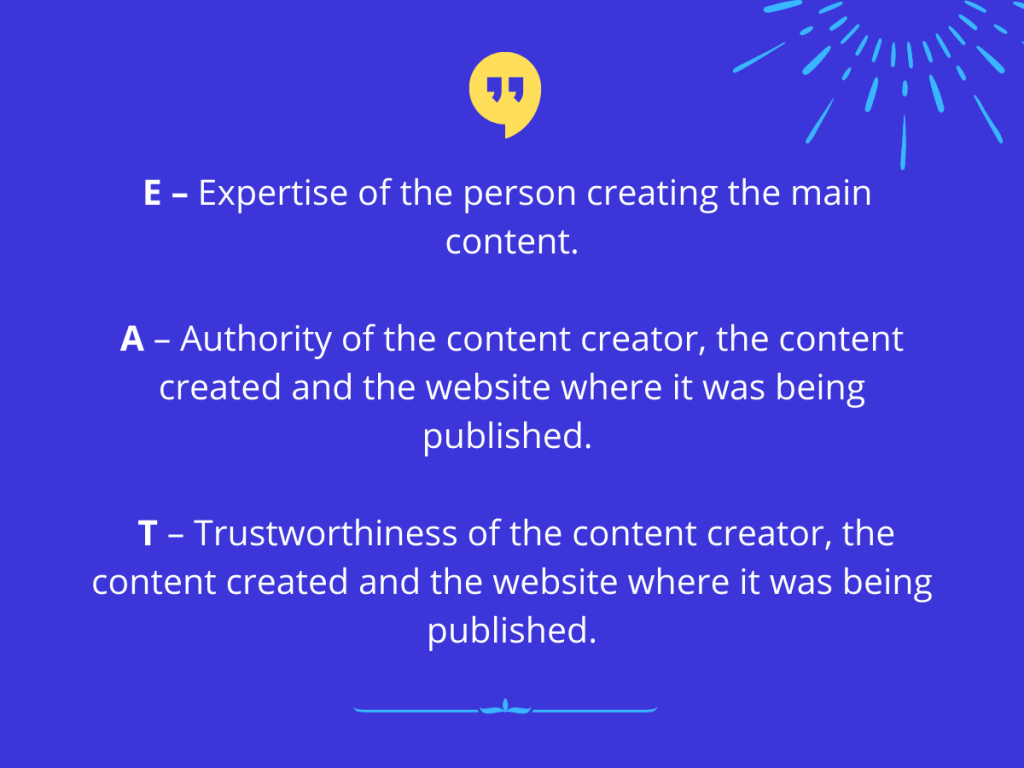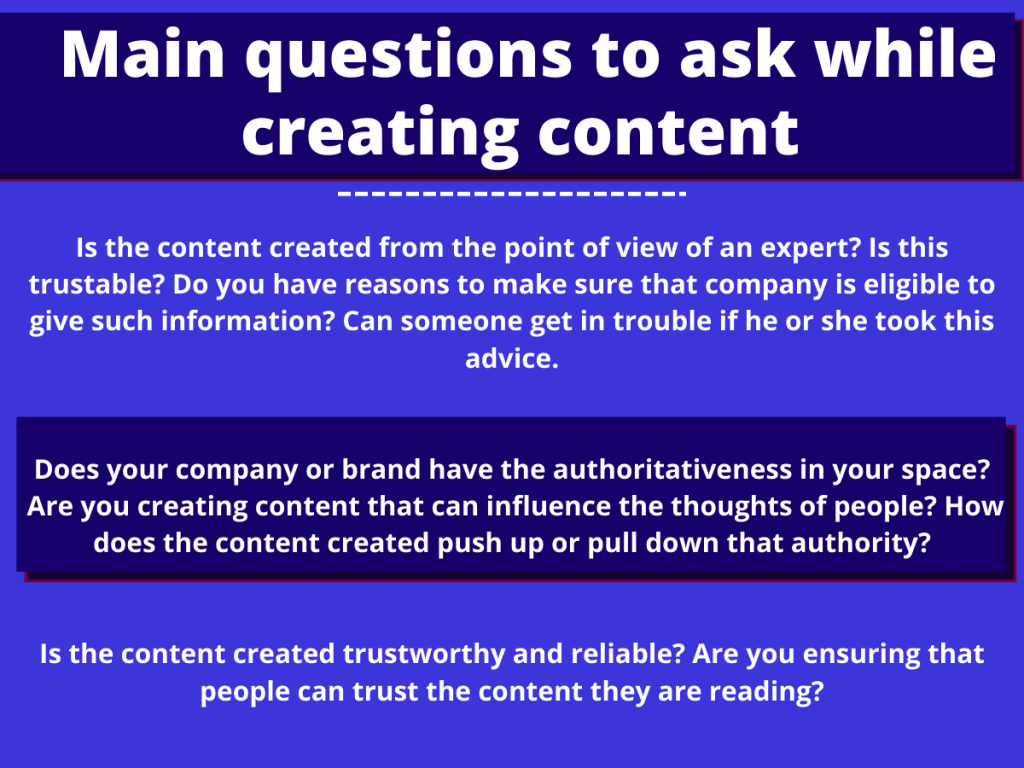This post answers the question:” How can I improve content marketing for my business?”
Are you ready to learn more about the latest content marketing trends? Ready to decode the secrets of content marketing?
Let’s dive in.
#15. Enhance the authority of Content with the 3C framework
The online searcher is seeking a solution for a problem.
The internet is flooded with content that offers them an answer. But who should the online user trust?
Since 2022, Google has focused on improving the ranking of original and helpful content that addresses the searcher’s queries and reducing unhelpful and non-original content.
The 3C content framework of clear, compelling, and credible content will help you enhance your content, improve your Google ranking, and help searchers find answers to their queries.
Clear and Concise Information—Improve the UX with concise information that answers the search query. If, for example, the audience is looking for content marketing trends, provide them with that. Don’t overwhelm your blog with content marketing basics or general concepts.
Keep sentences short and to the point and focus on what is important. Keeping content concise and simple will enhance clarity. Good writing makes hard concepts easy to digest and remember,
Aim to add value and information that helps the searcher do something with the content.
Compelling content should focus on the target searchers’ pain points to keep the reader’s attention. It should specify, “What’s in it for me?” and speak the readers’ language.
Compelling content is:
Informative: Content that is useful to the reader and provides the information the reader wants
Engaging: Content that “pulls” the readers in and lets them feel compelled to read more.
Targeted: Content should be targeted to the audience. Understand your audience – what they do and do not know.
To the point: Most Online users want short content that provides the answers they seek.
Credible content – The content you create must have the power to gain the trust of your audience. Create content for the top of the funnel – the stage where the searcher searches for a solution online. This is the first time your content interacts with them, and it should provide an answer to their queries.
Credible content requires in-depth research. You may need to use independent, external sources, including data-driven insights, expert opinions, and overall industry trends. Developing quality content takes time and effort, but it’s worthwhile and will pay dividends. From then on, it’s a journey of trust.
It’s the concept of “pull marketing,” where you attract your potential customer through several stages of the customer’s journey by building trust.
#14. Create to impress people, not the algorithm. Remember Google’s E_A_T
In the past, you might have been successful if your writing was dictated completely by keywords provided by your SEO team. Even “stuffing” keywords in your content might have been successful. But times have changed. As the Google algorithm updates change the focus, the usual “SEO stuff” that dictated content in the past is less relevant today.
The focus has shifted to content produced by real people for real people. Your blog might still attract users because it’s SEO-optimised, but if readers do not see value in your content, they may flee and never return.
Always focus on creating user-oriented content and answering searchers’ questions. Remember, every customer, especially your target audience, has started a search with something in mind—he or she is trying to find an answer to something. Try to answer those questions in as much depth as possible.
Google aims to enhance the UX (User Experience) and improve the ranking of original and helpful content that addresses the searcher’s queries. Google rewards content that shows the depth of quality and is consistent with its E-E-A-T guidelines (Experience, Expertise, Authority, Trustworthiness).
So what can you do?
Write long-format content that explains details about a particular topic. Link that to a pillar page, further establishing your authority on the subject. Keywords are important, but do not let them dictate your content. Focus on E-E-A-T.
Handpicked Content: Here is an example of a popular pillar page that we created
#13. The power of valuable content is incredible
Valuable content is content that readers can use to improve some aspect of their lives. Customers can interact with various content types, but nothing can replace the power of valuable content.
Brands should devise ways to create content that adds value to their customers. The best way to do that is to understand what customers want and at which stage of their buying journey.
Here are the traits that valuable content typically has.
Produce relevant content.
The content should answer the questions your buyers seek at each journey stage. Understand the typical questions a buyer might ask at every stage and what questions you can solve to convert him or her into a customer. Design your content based on those questions, depending on your industry, space, or product/service.
The best way to create relevant content is to create a buyer persona for your business and find the relevant questions he might have as he searches for an answer to his pain point, discovers your brand, searches for more brands, and evaluates your brand against others, and finally settles down for a purchase”.
Offer Unique Value with Your Content.
Your content should offer potential customers unique value. Avoid generic content that lacks value.
For example, for one of our clients, who gives loans for two-wheelers, we help the typical buyer understand more about two-wheelers through blogs like:
“The best fuel-efficient two-wheelers to buy in 2020,” and
“Two-wheeler or personal loan: which is better when you want to buy a bike?”
For an e-commerce customer who sells wooden furniture, we explain how to spot natural wood, the different types of wooden furniture, what to buy, etc.
The idea is to empower a potential buyer with all possible information that might be useful for him, solving his pain point.
Clear and authentic content
When you create content and visuals, imagine yourself in the buyer’s shoes, consider his questions, and then work on those.
With authentic content, you aim to connect with potential customers by providing relatable and honest information that entertains and educates your audience (rather than trying to sell or impress). It’s like having a sincere conversation that resonates with the audience personally, builds trust, and fosters genuine engagement, helping them form strong and loyal connections with your brand.

What is important is serving the right content at each stage of the Buyer Journey. Through your content, you are moving the buyer through every stage of the buyer journey and pulling him to finally make a purchase.
#12. Personalized Content a way to reach audiences’ heart
Millions of blogs are posted daily. With so much online content, how do you stand out from the crowd?
The answer lies in personalization: “71% of consumers expect brands and marketers to deliver personalized content. And 76% get frustrated when this doesn’t happen.”
In this digital era, companies are constantly competing to get the attention of their customers. Most companies fail to make an adequate impact for one key reason: insufficient focus on customer relationship management.
Most experts in the field consider personalized and targeted marketing the core process for ensuring customer retention. Personalized content is tailored to your audience’s needs and interests, making it more relevant, engaging, and effective.
The reasons behind this are simple: first, it shows that you care about your customers and want to know if they find any value in your goods or services. Second, it makes them feel engaged, eventually leading to their sticking to your content.
Personalized content helps build personal relationships between the brand and the consumer. Research has shown that sales opportunities increase by 20% when customized content is used to nurture leads, so more and more marketers are using personalized content.
Personalization requires quality data (free from errors). The more data you have, the more chance you have to build a better connection with your audience. From having the name and email address to gathering the remaining demographics, interests, priorities, and preferences over time.
Start with an email campaign for the customers, analyze how they respond to your content, and make the modifications accordingly. The more they interact with your content, the easier it becomes to sell the product.
#11. Optimize the Content to stand out among others
Ranking high on Google and other search engines is undoubtedly beneficial.
If you want your content to rank and get traffic and relevant leads, continue reading and add this to the list of must-do Content Marketing Trends for 2024.
Let me explain.
When a search query is made, Google throws tons of results in front of the user! You’re losing money if your content doesn’t rank for the relevant query! Simple as that. That is why you need to optimize your content.
The State of Content Marketing 2024 Global Report, published by Semrush, offers some interesting facts on content optimization and its importance.
As part of the analysis, the Semrush team analyzed around 24,000 articles that ranked in the top 10 of Google and found that the ones that ranked high scored a 9 out of 10 in content optimization.
So, what is Content Optimisation?
In simple terms, it is a process that ensures that published content is technically sound enough to be found by search engine algorithms and shown to the right audience.
To be found by your audience, you need to rank in the top 10 results of Google, and to hit that space; you need to optimize your content for search. This includes using e.g.
- relevant keywords, meta, and title tags,
- the right links, headlines, and subheads,
- the right CTAs,
- images,
- etc.
Here are some quick pointers to optimize your content
1. Make sure you are using the right keywords in every article you write. Use tools like Ahrefs, Semrush, Moz, or even Google Keyword Planner to find short-tail and long-tail words with good volume.
Ensure you do not always pick the short keywords with the highest volume. Check the difficulty score. If it’s too high, focus more on longtail keywords with good search volume and less competition.
2. Use semantically related keywords. This means using keywords that have the same meaning as the main keywords you are using.
For example, if you are writing a story on “What is content marketing?” then also include the keywords “What is content strategy?”” Benefits of content marketing?” “Why should you do content marketing?” etc. These are all related to the same topic, which shows Google what the intent of the article is. The algorithm can then match it with the user’s search intent.
3. Use the proper structure to build your article. Once you have your headline and keywords, try to define the structure. You could also analyze the structures of the articles that are already ranking and see what they are using, such as H2, H3, and H4 headings.
Tools like Fraser or Outranking help by instantly showing you the highest-ranking articles and the structure used.
4. Pay attention to technical SEO elements. This means optimizing the title tag, H1 tag, H2 tag, and meta description. Also, optimize your blog URL.
This will contribute to the ranking of your content, so make sure you do this right.
5. Add visuals to your content, especially videos. According to the Semrush research, articles with videos drove in 83% more traffic. Articles with more than seven mages drive more traffic than those without images.
6. Hyperlink to other relevant pages of your website and blogs. This helps Google search bots understand the flow of the website and easily crawl the site.
7. Although keyword stuffing should not be done, do not ignore keyword density. Look at competitor articles and see how often and which keywords they use. This should give you an idea of the keyword density.
8. Update your content every six months. Add new keywords, information, and graphics to attract traffic to the updated content. This is one of the easiest ways to increase website traffic.
#10. Be a smart marketer by repurposing the content
Content is a valuable part of any marketing strategy, and repurposing the existing content is a smart content marketing trend. 65% (Semrush) marketers perform an audit of their content twice every year. You can use the content to build a new audience base, convey your expertise, express your brand voice, etc. For those interested in knowing how to do it, read our detailed blog on how to do a content audit.
Content repurposing is a way of re-using one type of content into another. Usually, the new piece of content serves a different purpose from the one you posted earlier. It is a time-saving and less-costly content marketing trend that works brilliantly.
How to repurpose the content?
- Pick any old post (Choose one with less engagement)
- Keep the same context and change the words.
- Adapt the content to suit the new content type. For eg, if you are converting a blog into a video, you will need to make it a lot shorter or crisper. Same goes for a carousel post, or possible an ebook or a podcast. The content style will need to change as per the format.
Excellent ways of repurposing content
Change the format
Re-use a blog or pillar page content into a video, listicle, social media content, carousel posts, or an ebook. Alternatively, re-use pres release copies videos into a blog, etc
Add an update to the old content.
How can you make the piece better today? Add images, latest inputs, videos, infographics etc.
Optimize the old blogs with new keywords.
If you see an old blog that has dropped in ranking, add relevant content with a smattering of short—and long-tail keywords and republish.
Repurposing the content attracts new audiences, increases your online presence, expands your reach, saves time and effort (in creating new content), and much more.
Handpicked Content: 9 best ways to reuse that blog pile in your archive and get more traffic
#9. Build community, not customers base
With millions of businesses out there, you need to stand differently. How will you do that?
By building a community, not a customer base.
Customers feel more connected and powerful when they are part of the brand community. The purpose and goal of your content marketing should be to build a strong community with which to interact.
Building a community from scratch is beneficial, but it takes much effort. To build trust and loyalty, create valuable, interactive, and engaging content for customers.
The question is: How to build a community with content?
Here are six tips.
- Listen to your audience. (Don’t just pitch out your services.).
- Invite your customers to contribute to your content, such as customer testimonials.
- Always keep your customer in mind while writing.
- Ask for their opinions about your products/services.
- Ask them what they want from you.
- Engage with them in comments and DMs.
You might have observed that all six points mentioned above revolve around a single focus: pay attention to your customers through your content.
Content formats you can use to develop your community
- Do webinars that share valuable information and insights to help the community learn something.
- Send out weekly newsletters to stay in touch with your community and share content your brand is creating to drive more interaction with your content.
- Get the community involved in your content. Use user-generated content like customer testimonials, case studies, reviews, etc., and customer stories.
- Offer free community downloads. These might include premium content like ebooks, case studies, whitepapers, and infographics that are likely useful for your audience.
#8. One size doesn’t fit all
Not every piece of content will resonate with each user. If you constantly deliver the same type of content, your users will get bored. It’s not the quality of the content—but rather, how you present it—that is causing them to lose interest!
To explain this better, let’s consider the types of content. People consume content in various formats, such as text, infographics, videos, or podcasts. Every form of content works in its way to meet the customers’ needs.
If social media is the primary medium through which your audience spends their time, Facebook or Instagram feeds might be your best bet for engaging them.
However, if you find that people are likely visiting your site for tips or information about your product, then developing a blog could provide them with exactly what they’re searching for and keep them coming back for more.
Video would be the best choice in terms of branding and brand loyalty. Video content has made a big splash lately because it offers a way to create more personal connections with customers by combining the perfect blend of images and audio while providing all relevant information within seconds rather than minutes.
When you research and learn more about your users, you can create the perfect blend of content that satisfies their needs.
Yes, it may potentially be a long process. But gaining authority makes it worth in the long run.
#7. Riches are in the niches
Irrespective of the content vertical, content has achieved a saturation point. Whatever query you search, you’ll get a similar answer because there’s so much competition—hundreds of brands discussing the same thing.
Getting an organic ranking for your targeted keywords becomes harder in this case. To overcome this, going “niche-specific” with your content will be wise to attract a particular target audience.
Here are a few reasons why you should niche down with your content
- It lets you stand out amongst the competition.
- It becomes easier to rank the content on search engines.
- Communication with a specific target audience makes customer conversion easier.
For example, instead of just writing “social media marketing trends,” write “a social media marketing strategy for the makeup industry.”
#6. Optimize content for voice search
Consider this: According to Statista, digital voice assistants (e.g., Siri, and Alexa) will reach around 8.4 billion units by 2024. This alone shows why you should pay special attention to voice-optimized content. Voice has already been hailed as the future of search, and hence, optimizing your content for voice will remain a top content marketing trend for 2024 and beyond.
As Google’s voice search becomes increasingly popular, we must understand that voice search differs from a typed query. Think of how you would talk and how would type in the same query.
Consider,e.g., an online search for a dentist:
A typed search may be “Dentists near me,”
versus a voice search: “Who are the best dentists in my local area?”
Note that the basic difference is that when we type, we tend to make our query around keywords. However, when we use voice search, we tend to become more conversational and use lengthy keywords to search, pushing search engines to understand the meaning behind the word or semantic search.
The below trend demonstrates the differences visually.
Over the years, Google has become better with semantic search, ensuring it understands the intent behind the meaning of the words used in voice search. That is why it becomes extremely important to know how to optimize your content for voice search; otherwise, you stand to lose out on all the traffic that voice searches drive.
An important point to remember: The results appearing for voice searches are usually very direct, prompt, and close to the point. Most answers are shown through rich snippets and knowledge graphs.
Key strategies to optimize for voice search
Focus on rich answers – Rich answers are quick and concise search results that Google shows through knowledge graphs, featured snippets, and knowledge boxes.
If you can prepare your content for rich answers, your content is most likely to be picked up for voice search queries.
Find long-tail keywords and phrases – Find the best long-tail keyword clusters that can be used with filler words.
Use FAQs and question keywords—Use tools to find FAQs and question keywords related to your business category.
Prioritize local search—Most voice searches are related to local queries, so incorporate local keywords in your content. Understand questions that local people might ask in your business category.
Be mobile-friendly—User experience is everything, so make sure your website is mobile-friendly and optimized for people using voice search.
#5. Video content, the real hack of Content Marketing
Marketing Videos are the preferred choice for content consumption. Additionally, articles with videos tend to rank higher. A video engages your ears, eyes, and brain with information, making it easier for the brain to process it.
A report by InVideo shows that in 2020, 96% of consumers have increased their online video consumption, and 9 out of 10 viewers want to see more videos from brands and businesses. Additionally, it has been estimated that in 2024 the average person will spend 100 minutes per day watching videos.
Therefore, video content marketing is a trend you cannot ignore.
Handpicked Content:
Top 7 video marketing practices for business success
The 3 main steps of video production: A short guide
#4. Interactive continues to rock
Millions of pieces are being published every day. We all know this. Audiences have become blind to standard content. So, your audience is most likely not interested in your blog or video unless they want something particular.
Interactive content works because it allows customers to interact differently with the brand. It keeps the consumer engaged as it requires active attention, making a long-lasting impression. It’s more fun, interesting, and engaging and directly affects sales conversion and revenue generation.
Here are interactive content formats that can be created for your content marketing campaign.
- Quizzes, polls, games, surveys—These not only help generate loads of first-party data (which can be used to decide what kind of content should be created for your audience in the future) but also keep your audience engaged by testing their knowledge on a particular topic. Since Buzzfeed made quizzes popular, many brands have successfully embraced this type of content.
- Calculators are a great tool for attracting more users to your website and keeping them there. Largely used by the BFSI (Banking, Financial Services, and Insurance) sector, calculators are extremely good for the middle of the funnel stage, where you want customers to return to your website.
- Videos—Videos are already engaging, but you can make them more engaging by making them interactive. These work amazingly in the bottom of the funnel when you want to delight the customer by giving him something to remember and pushing him down to purchase.
For example, take a look at Harvard’s interactive virtual tour of its campus.

- Adding interactivity elements can make ebooks, Case studies, and Infographics more engaging.
- Product Recommendation Quizzes—If you have bought through Amazon or any major e-commerce website, you must have answered these questions. These are designed to understand what you like and prefer and then offer you recommendations based on your feedback.
- Assessments or questionnaires are interactive content that works extremely well.
- Webinars—Post-pandemic webinars have become big hits in drawing audience attention. They are excellent lead magnets, especially for B2B businesses, and work tremendously well in the middle of the funnel stage.
Editor’s Note. And yes, just because it’s interactive content, don’t forget to track the results and insights to see how it’s working. A good way to start is by repurposing old content.
#3. Want to be Google’s favourite? Adhere to EAT guidelines
Google always focuses on providing the best answers for its search queries. That means page quality and content matter. Google made this clear when it put out the E-A-T concept in its search quality guidelines 2014. Later (2023), Google added another E to make it E-E-A-T. (Experience-Expertise-Authoritativeness-Trustworthiness)
It meant that while ranking a page, Google’s search quality evaluators would also be taking into consideration the below 4 factors –
E— Experience of the person with the matter presented as part of the content.
E— Expertise (having actual knowledge about the subject) of the person creating the content
A — Authoritativeness is the authority of the creator, the content created, the website where it was published, and the websites it is linked to.
T—Trustworthiness of the creator, the content created, and the website where it was being published. Trustworthiness increases with experience, expertise, and authoritativeness.

If you are writing about “Your Money, Your Life” topics, you should give special consideration to the E-E-A-T guidelines. This would be topics like:
Heath, beauty, vehicles, financial transactions, law, jobs and education, hobby and leisure, arts and entertainment, computers and electronics, food and groceries, retailers and merchandise, home and garden, sports and fitness, internet and telecom, finance, apparel, travel, and tourism
Even if you are not creating YMYL content, following E-E-A-T guidelines is essential to improving the content’s value and ranking.
How to incorporate the E-E-A-T guidelines while creating content
Make sure that the main content of the website and the main content of each of the pages are aligned with each other.
Get experts to write for the category you belong to. You can use their interviews in your content if you cannot get them to write.
Build good links to your site since it matters which website links back to you.Always ensure you create “link-worthy” content. Do not put content on your website just for the sake of it.
Think 10X growth content. How can you put out content that establishes your authority? 10X means 10 times better than what has already been published by your competitors. If someone has written “25 ways to get a great blog,” write about 100 ways.

Main questions to ask while creating content
While creating “EEAT-compliant content,” question things.
For example:
Is the content created from the point of view of an expert? Is this trustable? Do you have reasons to ensure the company is eligible to give such information? Can someone get in trouble if he or she takes this advice?
Does your content creation company or brand have the authority in your space? Are you creating content that can influence people’s thoughts? How does the content created push up or pull down that authority?
Is the content created trustworthy and reliable? Are you ensuring that people can trust the content they are reading?
You might want to check this out: Google’s Search Quality Raters: Here is What They Say About High-Quality Pages and Content
#2. AI, the game-changer in Content Marketing
Today’s marketers spend hours strategizing, researching, designing, and creating content for the audience. AI simplifies that by helping marketers collect, mine, and create content-based data more effectively and efficiently.
Here is why using AI is growing in importance as a Content Marketing Trend.
- Create content more efficiently with AI
As the need for content continues to increase and the competition to rank on page 1 of SERPs gets higher, we need tools to help us understand what to include in our content to help us rank higher or create content faster. AI tools can do that.
AI cannot overtake the human brain’s expertise in writing great content, but it comes very close. AI is a helpful and efficient tool that provides useful tips, supports faster content development, and helps you with data to rank higher.
AI tools are here to stay.
- Extract data in real time and understand your audience.
A big part of a content marketer’s job is to know what type of content works and what is not and how to create content based on what the audience likes.
With AI tools, content creators can create content that is finely aligned with what their target audience wants by understanding their behavior and choices. With focused targeting, AI can help marketers create content to drive better engagement and sales.
- Create personalized content with data mining on social media
With the average individual spending almost two hours on social media daily, it makes sense to understand your target audience’s behavior on social media. E.g., what they prefer to read, who they follow, who they trust, what brands they like, and much more.
AI can help by using social media data mining and analysis, giving valuable customer insights.
The more you understand your customers and their choices, sentiments, and behavior, the more personalized your content can be. You also serve content that helps push more leads down the sales funnel.
AI is helping content marketing to be more efficient in four ways;
- Chatbots are making 24/7 interaction possible. Chatbot responses mimic real conversations to offer fast answers to customers,
- Support content creators in developing better content strategy and more engaging, rank-worthy content with insights and research.
- Shrink research time and enable faster content creation.
- AI offers predictive analysis for marketers. This allows them to offer content that is more aligned to each stage of the buyer’s journey.

#1. Create UGC to build brand credibility
According to a report named State of UGC in 2024, published by a marketing company called Tint, UGC (User-generated content) is a must-have nowadays, especially if you are in e-commerce.
One significant fact mentioned is that 76% of shoppers had bought a product because someone recommended it. The personalized shopping experience is at its peak now, and the more you can offer that, the more customers you will get. User-generated content, or UGC, is always considered more authentic and credible than a slick advertisement.
Your content’s ranking will also improve since Google’s algorithm update in March 2024 was another step to make finding content produced by real people for real people easier.
Reviews and recommendations are always considered more credible than a great ad since they are from a brand discussing its product.
The basic conclusion is that UGC has been a major content trend before and will continue to dominate the content scene.
Here are the benefits of user-generated content and why it helps drive sales.
- Convince Consumers with authentic and trustworthy UGC
Did you know that 9 out of 10 customers (89%) globally check reviews before buying a product? If you don’t have UGC, you are losing sales. This means that UGC is central to the buying process and ranks highly in content customers trust and believe in.
79% of customers trust online reviews to personal recommendations. If you run an online business, you should immediately include your clients’ reviews and recommendations on your website.
Remember how you get swayed by customer reviews on Amazon? That proves the point. People TRUST other buyer reviews more than they trust a great ad done by your brand.
The bottom line is that UGC content is considered authentic and trustworthy.
- Build brand trust with UGC.
Trust is an important currency in sales. If your customers trust your content, they will trust your brand. UGC content is one of the best ways to earn that trust.
Remember that the reviews need to be authentic to gain trust.
- Increase customer engagement using UGC.
A Comscore study showed that customer engagement was 28% higher when a brand used UGC content in various media channels, such as social media feeds, blogs, websites, etc.
The usage of UGC is critical for customer engagement on all platforms.
- Save content creation costs with UGC.
The requirement to have content on more and more platforms means you have to create an “endless” amount of content. UGC can be a cost-effective way to help with that. And even better, it may even work better than non-UGC content. With fierce competition and the need to be present on almost every platform and meet your customers where they are, you need a well-thought-through UGC content strategy.
Out-of-the-box thinking can be a huge cost saver.
Here is a great example:
To showcase its powerful camera, iPhone asked users to submit their best photos on Instagram or Twitter with the hashtag #ShotoniPhone. The top 10 winning pictures were showcased on billboards and in Apple showrooms in some cities.
This one was shot by Prajwal Chougule, from Kolhapur, India.
This is what the photographer had to say about this work of art.
“I am a nature lover and love going on early morning walks with my iPhone 13 Pro. The ‘golden hour’ brings the best out of nature and is a photographer’s delight. Dewdrops on a spiderweb caught my attention, and I was fascinated by the way the dry spider silk formed a necklace on which the dew glistened like pearls. It felt like a piece of art on nature’s canvas.”
This initiative received a huge response and became an online movement that has worked wonders for the brand.
Do you want an iPhone to click pictures? Hell yes.
Reviews like this work miraculously for a brand trying to promote its product while letting its audience do all the talking—advertising at a minimum cost.
- Connects with millennials and Gen Z online with UGC.
Almost 35% of Gen Z’s believe that UGC content is more credible than brand content and are more likely to buy from a brand after viewing a positive, authentic influencer review.
Around 70% of UGC content is consumed by millennials, who spend a lot of time on social media. With the rise of e-commerce and social media, this will only increase.
In short, it is a must to invest in UGC content through:
- Social media
- Blogs
- Videos
- Reviews
- Hashtag campaigns

Choose the Right Content Marketing Strategy and Profit
Well done for making it through the entire article!
We discussed many current marketing trends, from the three-C framework and the use of AI to considering Google’s E-E-A-T. But don’t feel overwhelmed. Take it step by step. There is no need to implement everything at once. Start by choosing the first trend to focus on, make it part of your strategy, and then move forward.
It can be as simple as one-two-three:
One: Keeping current with content marketing trends is important in today’s fast-paced digital world. Trends introduce you to new ideas and formats that can increase traffic and revenue. However, remember that trends come and go, so don’t base your entire content marketing strategy on what works only this year.
Two: Remember the basics. It remains best to track what works for your target audience and business. Staying in touch with your audience is critical. Build your content strategy on the foundation of what works for your buyers. You are on the right track if you are already publishing content and getting a good traffic flow.
Three: Finally – and never lose sight of this. The golden thread weaving through all of this is the importance of creating a good story and top-quality content.
The right content marketing strategy will catapult your business forward. You’ll see your business starting to overflow with leads and conversions! Yes, It’s possible.
But don’t wait.
Pick the first content marketing trend to update your strategy – do it today.
We hope you liked this piece. Please let us know which content marketing trend you have adopted or will adopt this year.






